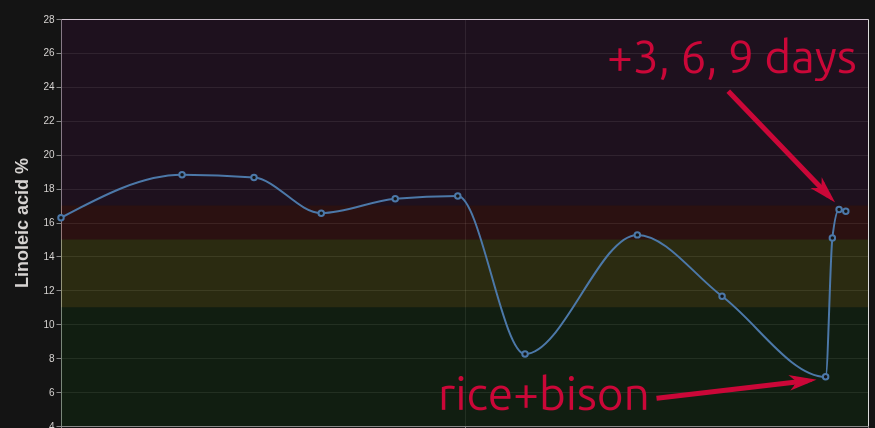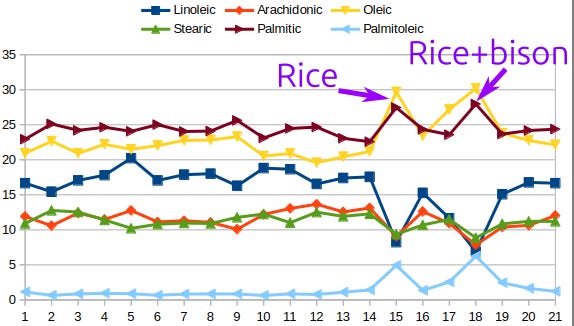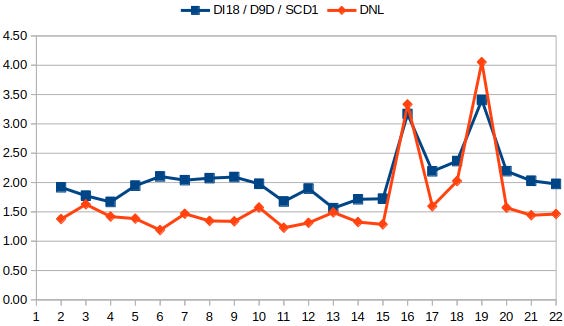You probably remember that I’ve recently been interested in the effects of HCLF (high-carb, low-fat) diets on linoleic acid in blood & adipose.
The idea is that inducing “essential fatty acid deficiency” (EFAD) on purpose could help lower adipose linoleic acid more rapidly.
Since we currently can’t measure adipose LA directly, I’m using the OmegaQuant Complete as a proxy.
One question many people have: how long do you have to do a strict HCLF diet until DNL (de-novo-lipogenesis) starts, and how long after you start eating high-fat until it stops?
Many people are interested in cycling these diets, and it would be important to know for that. Or just if you want to know how long a certain intervention might have to be until it works.
I historically had plenty of OmegaQuants on my ex150 diet, which is 90% fat, mostly from heavy cream. Generally, these were in the 16-17% linoleic acid range.
Then, I’d done the rice diet, with zero added fat. This lowered my (blood) linoleic acid dramatically, a new low of 8.24%. For various reasons, eating very-low-fat diets raises some other fatty acids in the blood, making linoleic acid seem lower than it would be on a high-fat diet.
About 50 days after the end of the rice diet and back on ex150, I took another OmegaQuant, which showed 15.27%. This was my lowest reading ever, except for the rice diet one.
It was a textbook example of my hypothesis: inducing EFAD (essential fatty acid deficiency) would force my body to use up a lot of stored linoleic acid. The reading would be artificially low during the diet, but a “normalized” reading back on a high-fat diet would still show a significant reduction in LA.
I was quite confident that 50 days would be enough to completely revert to a high-fat dietary state, without the “artificially suppressed” linoleic acid reading.
But 50 days is a very long time. Surely it didn’t take that long? Maybe I would’ve been at the same level 3 days after switching back to ex150, or 5, or 7, or 14?
In a rodent study, it had taken the rodents about 7-8 days to “switch modes” between low and high DNL. But how would this translate to humans?
With a bunch of OmegaQuant Complete tests to burn, I intended to find out. At the time I was in the middle of ex150hclflp, and I decided to take 1 OQC on the last day of that, and then on days 3, 6, and 9 after.
Without much ado, this is what the results looked like:
Huh! Interestingly, despite the addition of bison with ~10g of fat per day, my “artificially low reading” was even lower than on a pure rice diet, at 6.9%!
Just to make sure I looked it up, and I took both of these tests on the very last day of the rice and rice+bison diets respectively. So it wasn’t caused by being halfway through the experiment.
6.9% is the 5th lowest LA reading in the database of 183 results. Everyone who is lower is pretty much a fruitarian or an extreme Peater. This was the first surprise; I would’ve expected a reading somewhere between the pure rice and honey diet reading, maybe around 10% or so.
The next surprise was that just 3 days after ending the rice diet, my LA was back up to 15.08%, almost exactly at my previous 50-day-post-rice number.
But it kept rising! Day 6 was 16.77%, and Day 9 was down a bit at 16.66%.
I was quite surprised to see it jump up higher than my last reading. After all, my hypothesis would’ve predicted that another month of trying to induce EFAD would have lowered my LA to a new low. I had honestly expected ~14%.
My expectation was also that the jump back up would take much longer, maybe a linear increase over the 9 day period. instead, it jumped nearly all the way in 3 days, and days 6/9 were almost exactly the same number, close enough for the difference to be statistical noise.
Riddle me this
Honestly, I have no idea why it went back up higher than before. Could there be some rebound effect? Maybe, but why didn’t it rebound as high on pure rice?
Why’d it go lower on rice+bison than on rice alone?
Did I maybe eat sneaky accidental seed oils during my refeed? Maybe? But I think I ate nearly the same food as on the previous refeed, and that didn’t seem to make a difference.
The standard explanation on r/SaturatedFat when somebody’s OQC LA% goes up despite not having eaten any suspicious high-PUFA foods is as follows: you still have a lot of LA stored in your adipose tissue (that’s the whole point of depleting it), and some of that got out of your adipose tissue and entered your circulation, where it was picked up by cells to build new phospholipids (red blood cell PLs are part of the OQC score) and parts might still have been floating around your blood (another part of the OQC score).
It’s sort of like a puddle forming beneath your refrigerator when you’re trying to defrost it; it’s a good sign, even though puddles (or higher LA) are generally bad.
Let’s take a look at my weight over this time:
Oh, huh! I did rapidly gain weight in the beginning of ex_hclflp (the diet that ended up being mostly rice+bison), when I was adding fruit & honey to the rice & bison still.
The weight stabilized somewhat after that. The OQC taken on the morning after the end of the diet was at 236.5lbs, and I went down to 230.5lbs before the last test was taken.
Surely not all of that was fat, mostly water weight. But maybe some of it was? And that fat would’ve contained linoleic acid.
It could be that the EFAD induction worked as intended, my body released a bunch of fat from adipose tissue, and some of the LA in it was burned, while some was incorporated into RBC (red blood cell) phospholipids.
Since I only tested 50 days later, and the life of RBC is about 3-4 months, this effect might have happened directly after the rice diet, and I might’ve missed it. I suppose if I tested at ~50 days again, that would be a more conclusive comparison vs. last time.
There might very well be a zig-zag pattern that “overshoots” shortly after a phase of inducing EFAD and depleting LA from body fat, in which the newly-created RBCs are showing up, and then they disappear 3-4 months later and the total number sinks down lower.
Sort of like this:
I’m not sure I’m confident enough to call this a hypothesis. I’m mostly curious.
Like so many of these markers, only getting snapshots means we really don’t know how they behave day to day. I doubt (m)any people have as many OQCs as we do here in the tracker. We can now pretty confidently predict if people are eating low-fat or how much fish they’re eating just from seeing their OQC fatty acid profile (looking at you, palmitoleic & DHA).
But there are still a ton of mysteries, especially around the short-term and mid-term.
De Novo Lipogenesis
So far I’ve only shown you the LA% from my tests. But how do we determine if DNL is happening? Well, luckily, we have a pretty complete fatty acid profile in the OQC.
Shout out to Reddit user the14nutrition, who has been helping me understand the intricacies of this.
These are all my OQCs ever. the first half is just being in keto/ex150 type diets, and all of them look very similar.
But you can clearly see the rice diet. Oleic spikes, as do palmitic and palmitoleic. LA drops like a rock, and arachidonic and stearic drop a little bit but not nearly as much.
The situation mostly reverses between the rice and rice+bison diet, when I am back on ex150 and do the 50-days-post test.
Then, on rice+bison, the same thing happens - this time, palmitoleic spikes even higher, and LA drops even lower.
In the 3/6/9 day tests after the rice+bison test, the situation once again mostly reverses.
the14nutrition and I therefore think that palmitoleic acid is a great predictor of DNL in the body. At least in me. If anyone else wants to run before/after OmegaQuants around a switch from/to high-fat/low-fat, please let us know!
Here are a few other ratios that are relevant. First, DI18/D9D/SCD1 and DNL, both of which spike like crazy on rice and rice+bison, then go back down.
Next up, D6D, which measures the activity of the delta-6-desaturase enzyme. Same exact pattern. Only reason it’s not on the same chart is the vastly different scale, and my inability to spreadsheet good.
(I tried looking up what could’ve caused the spike in the very beginning at point 4, and apparently it was 2 days after I ended ex_fatfast, an experiment plagued by massive fuckarounditis, semi-starvation, cravings, and a bunch of fasting and overfeeding. Who knows wtf that did to me lol)
Anyway, these are just some more data points confirming when my body was creating a lot of fat from scratch (aka de novo lipogenesis), in case palmitoleic wasn’t enough.
Up Next
I already have the next OQC sitting on my shelf.
Today I finished up ex150-14, on which there really isn’t much to report but I’ll send a brief update soon.
After the refeed, I plan on doing the current hype diet - The Sugar Diet! It’s like the Honey Diet but without the meat for dinner. It’s just fruit, sugar, and honey all day long. I am not sure I’ll even last 7 days, lol, but some people are reporting miraculous results.
And it’s a great opportunity to test the opposite end of this phenomenon: switching from high-fat diet to very-low-fat diet, I will again do several OQCs and see how long it takes to upregulate my DNL.










The shorter time period stuff is really interesting to see. I can't wait to see what it looks like going the other way, and I'd love to see what it looks like for a swampy diet too!
I just discovered your research today, but I love it. Excited to follow your work.